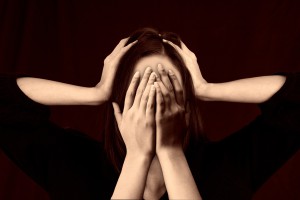Body Dysmorphic Disorder (BDD) Symptoms
Posted by Steven J. Seay, Ph.D. in Body Dysmorphic Disorder (BDD)
Body dysmorphic disorder symptom areas vary between individuals but commonly focus on the skin, hair, weight, and specific facial features.
Symptoms of Body Dysmorphic Disorder (BDD)
Body dysmorphic disorder (BDD) is a somatoform disorder that closely resembles obsessive-compulsive disorder (OCD). Symptoms of body dysmorphic disorder include excessive concern about perceived physical flaws, defects, or imperfections.
Individuals with body dysmorphic disorder become obsessed with these unwanted aspects of their appearance and perform a variety of rituals and avoidance behaviors in order to disguise or conceal these “flaws.” BDD symptoms typically result in extreme distress and a variety of social and occupational difficulties.
Body dysmorphic disorder symptom areas vary between individuals and commonly focus on the skin, hair, weight, and specific facial features, such as the nose (Philips, 2005).
In The Broken Mirror (2005), Dr. Philips breaks down the frequency of different types of BDD concerns:
| Skin | 73% | Genitals | 8% | |
| Hair | 56% | Cheeks/cheekbones | 8% | |
| Weight | 55% | Calves | 8% | |
| Nose | 37% | Height | 7% | |
| Toes | 36% | Head size/shape | 6% | |
| Abdomen | 22% | Forehead | 6% | |
| Breasts/chest/nipples | 21% | Feet | 6% | |
| Eyes | 20% | Hands | 6% | |
| Thighs | 20% | Jaw | 6% | |
| Teeth | 20% | Mouth | 6% | |
| Face size/shape | 20% | Back | 6% | |
| Legs overall | 18% | Fingers | 5% | |
| Lips | 12% | Neck | 5% | |
| Buttocks | 12% | Shoulders | 3% | |
| Chin | 11% | Knees | 3% | |
| Eyebrows | 11% | Ankles | 2% | |
| Hips | 11% | Body build/bone structure | 1.50% | |
| Ears | 9% | Facial features general | 1.40% | |
| Arms/wrists | 9% | Facial muscles | 1% | |
| Waist | 9% |
In my South Florida (Palm Beach County) psychological practice, I often treat individuals with body dysmorphic disorder whose BDD symptoms focus on specific facial features or skin quality. They often worry about facials scars, pores, dimples, moles, birthmarks, skin tags, hair, wrinkles or lines, under-eye circles, or general facial symmetry. Some men have symptoms that include a preoccupation with muscle growth and development. This is sometimes referred to as muscle dysmorphia, or “manorexia”, and often involves a preoccupation with muscle symmetry and fears about being “too skinny” or “too small”. Regardless of the body area of concern, BDD involves appearance-related perfectionism.
For people with body dysmorphic disorder, concerns about body symmetry are quite common. Individuals may worry about the symmetry of specific body parts (breasts, buttocks), facial features (eyes, eyebrows, ears), or the distribution of body hair. Other individuals experience excessive concern about scarring from elective cosmetic procedures or enhancements (e.g., over-concern about the appearance of one’s breasts following breast augmentation).
Symptoms of body dysmorphic disorder are maintained by rituals and avoidance behaviors. These behaviors are often targeted in treatment of BDD in the context of exposure and response prevention (ERP). Although ERP is traditionally considered a treatment for obsessive-compulsive disorder, ERP is also an effective treatment for BDD.
Body Dysmorphic Disorder (BDD) Avoidance Behaviors & Rituals
- Social anxiety, isolation, and avoidance.
- Avoidance of dating and sexual intimacy.
- Avoidance of places with bright, intense lighting that might highlight or reveal perceived flaws.
- Avoiding particular activities like swimming.
- Avoiding exercise (or other sweat-inducing activities) or (in other cases) over-exercising.
- Performing facial exercises or other exercises targeting specific BDD concerns.
- Staying at home during rainy or windy days.
- Limiting or avoiding eye contact with others.
- Keeping the face in profile to prevent others from noticing assymetries.
- Spending excessive time in preparing to go out.
- Repeatedly checking in the mirror or inspecting one’s appearance.
- Repeatedly applying/reapplying make-up to modify or disguise any perceived defect.
- Repeatedly brushing or styling the hair.
- Repeatedly shaving the skin.
- Wearing bulky/oversized clothing to disguise the defect.
- Limiting contact with real-life friends (but potentially not online friends).
- Avoidance of situations where photographs or videos will be taken.
- Checking appearance in mirrors and reflective surfaces.
- Touching or inspecting perceived flaws.
- Wearing hats or wigs.
- Use of hair-growth products like Rogaine.
- Reassurance-seeking (asking other people if they can see the defect).
- Trying to convince other people of the defect’s existence.
- Closely monitoring other people’s reactions and eye movements in social situations.
- Skin-picking, rubbing, or smoothing the skin.
- Tweezing and plucking hair.
- Getting frequent haircuts or frequently trimming one’s own hair.
- Avoiding form-fitting clothing or any clothing that feels restrictive or puts pressure on the skin.
- Excessively dying the hair.
- Repetitive surgical alterations of one’s appearance.
- Excessive use of products designed to prevent aging or restore one’s appearance.
- “Flexing and checking”, excessive exercise, excessive eating, and the use of anabolic steroids or growth hormones (in muscle dysmorphia).
Want to learn more about BDD? Read my previous post that provided an overview of body dysmorphic disorder.
Questions? Comments? Do you experience symptoms of body dysmorphic disorder (BDD) that weren’t included above? Sound off below.
…or continue the discussion on Facebook, Twitter, or Google+.




